

Body Language. Throughout history it has been an advantage if an individual can read body language.
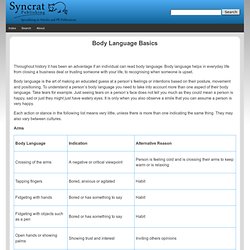
Body language helps in everyday life from closing a business deal or trusting someone with your life, to recognising when someone is upset. Body language is the art of making an educated guess at a person’s feelings or intentions based on their posture, movement and positioning. To understand a person’s body language you need to take into account more than one aspect of their body language. Take tears for example. Just seeing tears on a person’s face does not tell you much as they could mean a person is happy, sad or just they might just have watery eyes. Each action or stance in the following list means very little, unless there is more than one indicating the same thing. Arms Feet Head Chest. Out-of-the-box thoughts. How to Annoy.
How to spot a liar: Viewzone. We have all met people who were dishonest and avoided eye contact.
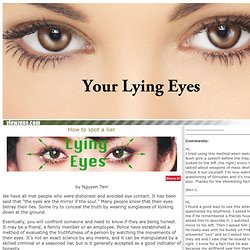
It has been said that "the eyes are the mirror if the soul. " Many people know that their eyes betray their lies. Some try to conceal the truth by wearing sunglasses of looking down at the ground. Eventually, you will confront someone and need to know if they are being honest. It may be a friend, a family member or an employee. The following are some general patterns that you can use when talking to someone. Here is a more detailed explanation of this method: Up and to the Left: Indicates a visually constructed Images. Up and to the Right: Indicates a Visually Remembered Images. To the Left: Indicates an Auditory Construct thought. Body language. Body language is significant to communication and relationships.
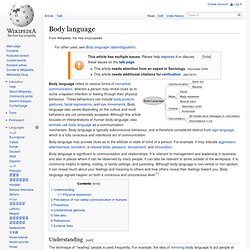
It is relevant to management and leadership in business and also in places where it can be observed by many people. It can also be relevant to some outside of the workplace. It is commonly helpful in dating, mating, in family settings, and parenting. Facial Expression Animation: face.htm. Emotion Expression - Emotion Faces and Facial Analysis. Neither emotion nor its expression are concepts universally embraced by psychologists.
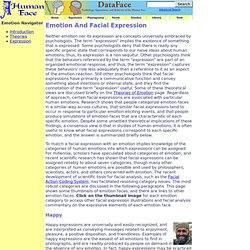
The term "expression" implies the existence of something that is expressed. Some psychologists deny that there is really any specific organic state that corresponds to our naive ideas about human emotions; thus, its expression is a non sequitur. Other psychologists think that the behaviors referenced by the term "expression" are part of an organized emotional response, and thus, the term "expression" captures these behaviors' role less adequately than a reference to it as an aspect of the emotion reaction.
Still other psychologists think that facial expressions have primarily a communicative function and convey something about intentions or internal state, and they find the connotation of the term "expression" useful. Some of these theoretical views are discussed briefly on the Theories of Emotion page. Happy Sad Anger Fear. Body Language Basics Summary - Syncrat Publishing. Body language. Understanding Body Language - Reading Body Language. Body Language - guide to reading body language signals in management, training, courtship, flirting and other communications and relationships. Body language. Analyse transactionnelle. Cet article présente des problèmes multiples.
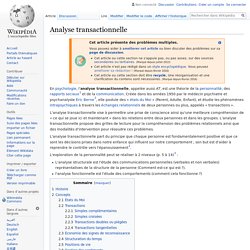
En psychologie, l'analyse transactionnelle, appelée aussi AT, est une théorie de la personnalité, des rapports sociaux[1] et de la communication. Créée dans les années 1950 par le médecin psychiatre et psychanalyste Éric Berne[2], elle postule des « états du Moi » (Parent, Adulte, Enfant), et étudie les phénomènes intrapsychiques à travers les échanges relationnels de deux personnes ou plus, appelés « transactions ». L'analyse transactionnelle vise à permettre une prise de conscience ainsi qu'une meilleure compréhension de « ce qui se joue ici et maintenant » dans les relations entre deux personnes et dans les groupes.
L'analyse transactionnelle propose des grilles de lecture pour la compréhension des problèmes relationnels ainsi que des modalités d'intervention pour résoudre ces problèmes. L'exploration de la personnalité peut se réaliser à 2 niveaux (p. 5 à 14)[3] : Histoire[modifier | modifier le code] Get to Know The Faces You’ll See Everyday in Korea – Who’s on South Korean Money. Get to Know The Faces You’ll See Everyday in Korea – Who’s on South Korean Money Keith Blog, Just for Fun 23.

How to use the law of attraction - good feeling thoughts. Know what you do want – know what you don’t want One of the main points in creating the life that you want is understanding and deciding what you don’t want, then using it as a springboard to what you do want.

How to Read Body Language to Reveal the Underlying Truth in Almost Any Situation. 'Glass hold' reveals personality. Which type are you?
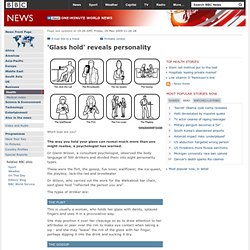
The way you hold your glass can reveal much more than you might realise, a psychologist has warned. Dr Glenn Wilson, a consultant psychologist, observed the body language of 500 drinkers and divided them into eight personality types. These were the flirt, the gossip, fun lover, wallflower, the ice-queen, the playboy, Jack-the-lad and browbeater. Dr Wilson, who carried out the work for the Walkabout bar chain, said glass hold "reflected the person you are".
The types of drinker are: This is usually a woman, who holds her glass with dainty, splayed fingers and uses it in a provocative way. She may position it over her cleavage so as to draw attention to her attributes or peer over the rim to make eye contact when taking a sip - and she may "tease" the rim of the glass with her finger, perhaps dipping it into the drink and sucking it dry. Again, usually a woman who clusters together with her friends.